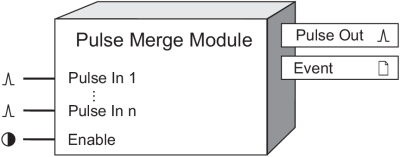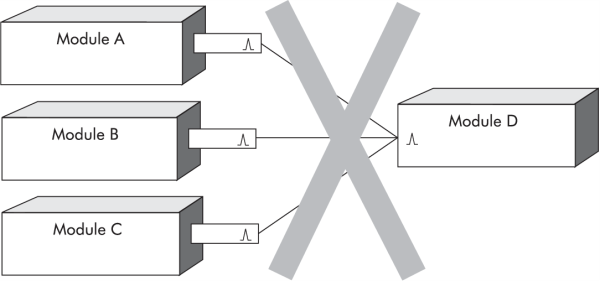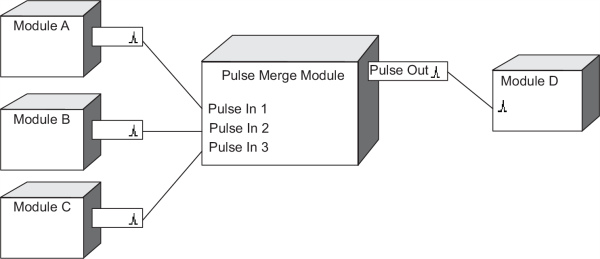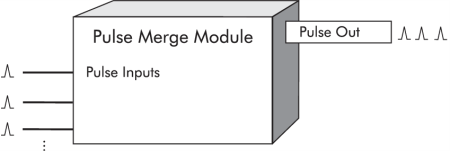Pulse Merge Module
The Pulse Merge Module takes input pulses from multiple sources and combines them into a single output register.
Module icon
![]()
Overview
It is useful for triggering modules that should execute as a result of several different conditions. In other words, if a module needs to be triggered when any one of a group of other modules generates an output pulse, you can merge all the output pulses to a single Pulse Merge Module. The Pulse Merge Module then outputs a pulse whenever it receives an input pulse.

NOTE: The registers and settings available in this module depend on the device or node you are configuring, as well as its firmware and template versions. Not all registers or settings are available on all devices or the Virtual Processor, and labels may vary.
Inputs
 Pulse In 1 to Pulse In n
Pulse In 1 to Pulse In n
A pulse received on any of these inputs causes Pulse Out output register to generate a pulse. At least one of these inputs must be linked for the module to operate.
 Enable
Enable
This input enables or disables the Pulse Merge module. If you disable a Pulse Merge module, pulses on the Pulse In inputs are ignored. Linking this input is optional; if you leave it unlinked, the module is enabled by default.
Setup registers
 EvLog Mode
EvLog Mode
This setup register determines whether or not pulses received on the inputs are logged as events by the Event output register. If the module is enabled and the EvLog Mode register is set to log on, an event is logged each time a pulse is received. The event indicates which input has been pulsed. If EvLog Mode is set to log off, these events are not logged. Note that in either case, the actions of linking the module inputs and changing setup registers are still logged as events in the Event output register.
Output registers
 Pulse Out
Pulse Out
This register outputs a pulse anytime a pulse is received at any of the Pulse In inputs.
 Event
Event
All events are recorded in the Event register. Possible events and their associated priority numbers are:
| Event priority group | Priority | Description |
|---|---|---|
| Setup Change | 10 | Input links, setup registers or labels have changed. |
| Input Register Change | 15 | Pulse received on Source input. * |
| * These events are only recorded if the EvLog Mode setup register is set to log on. | ||
The Event output register stores the following information for each ION event: time stamp, priority, cause, effect, and any values or conditions associated with the cause and effect.
Responses to special conditions
The following table summarizes how the module behaves under different conditions:
| Condition | Response of output registers |
|---|---|
| When the module is first created | The Pulse Out output will not pulse until the inputs are evaluated. |
| If the Enable input is off | The Pulse Out output will not pulse. |
| After the module is re-linked or its setup registers are changed | The Pulse Out output will not pulse until the inputs are evaluated. |
Detailed module operation
The primary function of the Pulse Merge Module is to act like an OR gate for pulse outputs. As shown in the diagram below, you cannot link multiple output registers into a single input.

The Pulse Merge Module solves the problem because it outputs a pulse whenever one of its multiple inputs receives a pulse. The solution is illustrated in the diagram below. Module D is triggered by the Pulse Merge Module when any of Modules A, B, or C output pulses.

The following figures show the module operation under various input conditions:
A single pulse on three separate inputs results in three pulses out:

Three pulses on one input results in three pulses out:

Three pulses on one input and two pulses on a different input results in a total of five pulses out:
